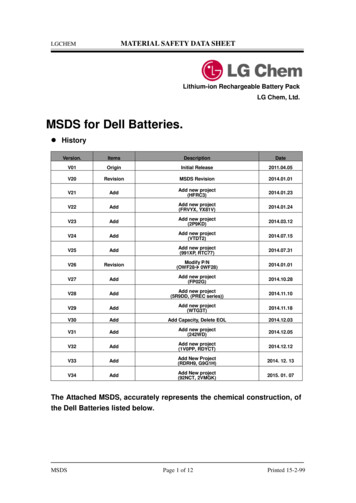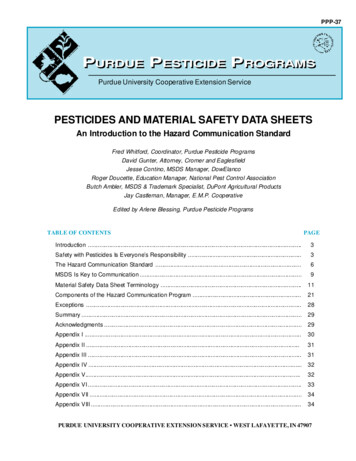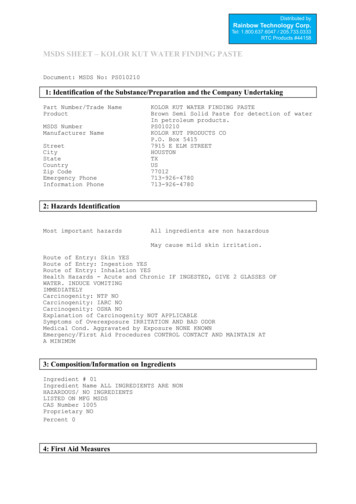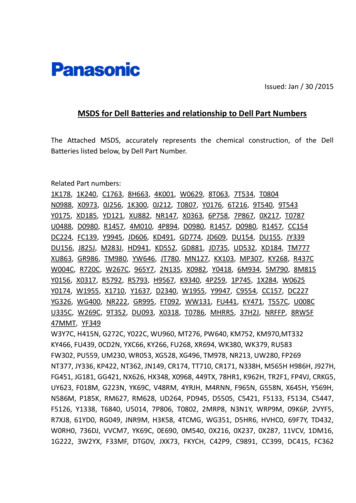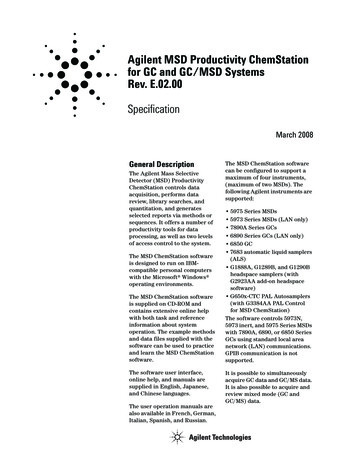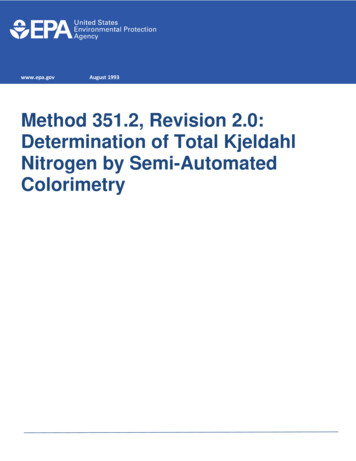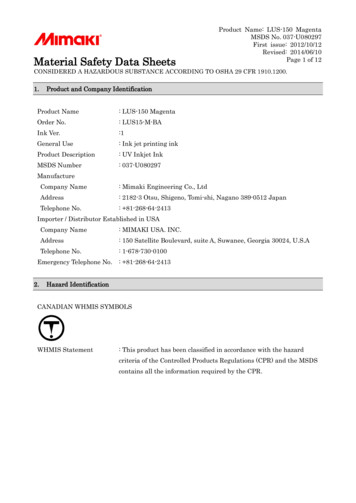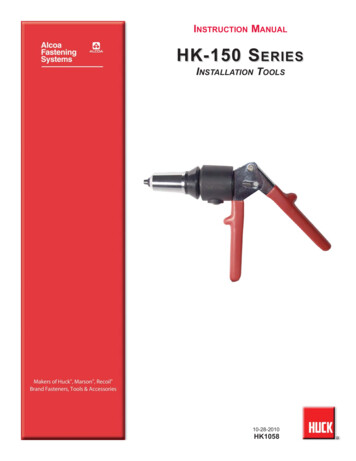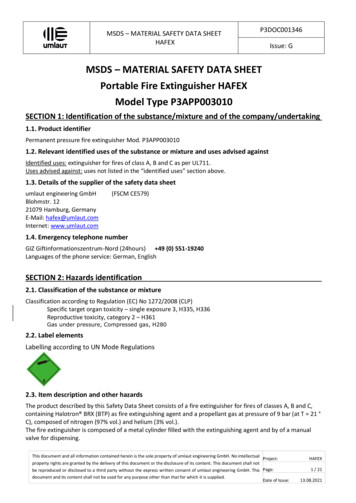
Transcription
MSDS – MATERIAL SAFETY DATA SHEETHAFEXP3DOC001346Issue: GMSDS – MATERIAL SAFETY DATA SHEETPortable Fire Extinguisher HAFEXModel Type P3APP003010SECTION 1: Identification of the substance/mixture and of the company/undertaking1.1. Product identifierPermanent pressure fire extinguisher Mod. P3APP0030101.2. Relevant identified uses of the substance or mixture and uses advised againstIdentified uses: extinguisher for fires of class A, B and C as per UL711.Uses advised against: uses not listed in the “identified uses” section above.1.3. Details of the supplier of the safety data sheetumlaut engineering GmbHBlohmstr. 1221079 Hamburg, GermanyE-Mail: hafex@umlaut.comInternet: www.umlaut.com(FSCM CE579)1.4. Emergency telephone numberGIZ Giftinformationszentrum-Nord (24hours) 49 (0) 551-19240Languages of the phone service: German, EnglishSECTION 2: Hazards identification2.1. Classification of the substance or mixtureClassification according to Regulation (EC) No 1272/2008 (CLP)Specific target organ toxicity – single exposure 3, H335, H336Reproductive toxicity, category 2 – H361Gas under pressure, Compressed gas, H2802.2. Label elementsLabelling according to UN Mode Regulations2.3. Item description and other hazardsThe product described by this Safety Data Sheet consists of a fire extinguisher for fires of classes A, B and C,containing Halotron BRX (BTP) as fire extinguishing agent and a propellant gas at pressure of 9 bar (at T 21 C), composed of nitrogen (97% vol.) and helium (3% vol.).The fire extinguisher is composed of a metal cylinder filled with the extinguishing agent and by of a manualvalve for dispensing.This document and all information contained herein is the sole property of umlaut engineering GmbH. No intellectualProject:property rights are granted by the delivery of this document or the disclosure of its content. This document shall notbe reproduced or disclosed to a third party without the express written consent of umlaut engineering GmbH. This Page:document and its content shall not be used for any purpose other than that for which it is supplied.Date of Issue:HAFEX1 / 2113.08.2021
MSDS – MATERIAL SAFETY DATA SHEETHAFEXP3DOC001346Issue: GSECTION 3: Composition/information on ingredients3.1. SubstancesN/A3.2. MixturesThis product has been identified as “article” in accordance with the Reg. (CE) 1907/2006 “REACH”and Reg. (CE) 1272/2008 “CLP”.Fire extinguisher contents:Substance2-bromo-3,3,3-trifluoro-1propene (BTP)nitrogen, pressurizedhelium, pressurizedIdentificationnumberCAS n. 1514-82-5EC n. 627-872-0QuantityCAS n. 7727-37-9EC n. 231-783-9CAS n. 7440-59-7EC n. 231-168-597% vol. of propellantClassification(Reg. CE 1272/2008)H335 STOT SE 3H336 STOT SE 3H361 RT 2H280 Press. Gas3% vol. of propellantH280 Press. Gas100% of extinguishing agentSECTION 4: First aid measures4.1. Description of first aid measuresInhalation: in case of inhalation of the extinguishing agent, move the person to fresh air, facilitatingbreathing. Call a physician if breathing difficulties occur.Skin contact: In case of contact with the extinguishing agent, remove contaminated clothing andfootwear. Consult a physician if irritation occurs.Eyes contact: in case of contact with the extinguishing agent, flush eyes with cool water and movethe person to an uncontaminated area. Contact a physician if irritation occurs.Swallowing: in case of swallowing of the extinguishing agent, do not induce vomiting. Seekimmediately medical attention.4.2. Most important symptoms and effects, both acute and delayedInhalation: overexposure to the extinguishing agent can cause effects on the central nervous systemsuch as dizziness, confusion, lack of physical coordination, drowsiness, anesthesia or loss ofconsciousness. At concentrations of 1.0% (v/v) or higher overexposure can lead to increasedsensitivity of the heart to adrenaline, which can cause irregular beats and possibly ventricularfibrillation or death.Skin contact: in case of contact with the extinguishing agent, effects of skin irritation or skin corrosionare not known.Eyes contact: in case of contact with the extinguishing agent, eye irritation effects are not known.4.3. Indication of any immediate medical attention and special treatment neededIn the event of the appearance of symptoms in the patient, contact a doctor urgently.This document and all information contained herein is the sole property of umlaut engineering GmbH. No intellectualProject:property rights are granted by the delivery of this document or the disclosure of its content. This document shall notbe reproduced or disclosed to a third party without the express written consent of umlaut engineering GmbH. This Page:document and its content shall not be used for any purpose other than that for which it is supplied.Date of Issue:HAFEX2 / 2113.08.2021
MSDS – MATERIAL SAFETY DATA SHEETHAFEXP3DOC001346Issue: GSECTION 5: Firefighting measures5.1. Extinguishing mediaSuitable extinguishing media: chemical properties of the extinguishing agent make it a suitableextinguishing media for fires of classes A, B and C. In case of fire or heat sources in proximity, themetal cylinder of the fire extinguisher can be chilled with water.Non-suitable extinguishing media: the extinguishing agent is not suitable for use against class K(burning fat, oil) fires.5.2. Special hazards arising from the substance or mixtureThe chemical properties of the extinguishing agent make it a suitable extinguishing media for fires ofclasses A, B and C. Overheating of the metal cylinder of the extinguisher can cause a sudden increaseof the propellant gas pressure and the evaporation of the extinguishing agent.The extinguishing agent vapors are heavier than air and are potentially dangerous if large volumesare enclosed in closed or lower areas.5.3. Advice for firefightersThe use of water can be useful for lowering the temperature of the metal cylinder of the fireextinguisher in case of intense heat source in proximity.SECTION 6: Accidental release measure6.1. Personal precautions, protective equipment and emergency proceduresIn case of loss or use of extinguishing agent, don’t accede to the area as long as proper ventilationwas applied.6.2. Environmental precautionsDespite the extinguishing agent is volatile and evaporates quickly, prevent the spillage andcontamination of surface water, ground water and sewerage.Do not dispose of empty or damaged fire extinguisher in the environment.6.3. Methods and material for containment and cleaning upThe extinguishing agent is a volatile material and evaporates quickly. In case of spillage, avoid contactwith the surface water, ground water and sewerage.6.4. Reference to other sectionsSee sections 8, 13 and 15.This document and all information contained herein is the sole property of umlaut engineering GmbH. No intellectualProject:property rights are granted by the delivery of this document or the disclosure of its content. This document shall notbe reproduced or disclosed to a third party without the express written consent of umlaut engineering GmbH. This Page:document and its content shall not be used for any purpose other than that for which it is supplied.Date of Issue:HAFEX3 / 2113.08.2021
MSDS – MATERIAL SAFETY DATA SHEETHAFEXP3DOC001346Issue: GSECTION 7: Handling and storage7.1. Precautions for safe handlingFire extinguishers, bearing seal and in compliance with current regulations do not allow theunintentional release of the extinguishing agent. Expel the extinguishing agent only in case ofemergency, for extinguishing fires of classes A, B and C.Handle the fire extinguishers with care: danger of falling and impact.Avoid contact with skin and eyes of the extinguishing agent.Wash after using and follow good personal hygiene practices.7.2. Conditions for safe storage, including any incompatibilitiesStore fire extinguishers away from excessive heat.Always place the fire extinguisher properly to avoid injury (e.g. wall anchoring, cages, chains).7.3. Specific end use(s)N/ASECTION 8: Exposure controls/personal protection8.1. Control parametersEXTINGUISHING AGENT (2-bromo-3,3,3-trifluoro-1-propene)DNEL (8 h)11 ppmUS EPA TSCA (8 h)1 ppm8.2. Exposure controlsEyes/face protection: if possible due to emergency conditions, while using the fire extinguisher,protect your eyes with safety glasses.Skin protection: if possible due to emergency conditions, while using the fire extinguisher, protectyour hands with gloves.Body protection: if possible due to emergency conditions, while using the fire extinguisher, protectyour body with appropriate clothing.Respiratory protection: if possible due to emergency conditions, while using the fire extinguisher,wear a mask with breathing apparatus.Thermal danger: exposure to intense heat sources for extended periods, can cause a sudden increasein pressure of the extinguisher interior components.This document and all information contained herein is the sole property of umlaut engineering GmbH. No intellectualProject:property rights are granted by the delivery of this document or the disclosure of its content. This document shall notbe reproduced or disclosed to a third party without the express written consent of umlaut engineering GmbH. This Page:document and its content shall not be used for any purpose other than that for which it is supplied.Date of Issue:HAFEX4 / 2113.08.2021
MSDS – MATERIAL SAFETY DATA SHEETHAFEXP3DOC001346Issue: GSECTION 9: Physical and chemical properties9.1. Information on basic physical and chemical propertiesa. appearanceb. odourmetal cylinderEXTINGUISHING AGENT solvent, comparable toether odour (if not stabilized), acid fruit (ifstabilizedc. olfactory thresholdN/Ad. pHN/Ae. melting point/freezing pointEXTINGUISHING AGENT: -111.2 CNITROGEN: -210 CHELIUM: -272 Cf. initial boiling point and boiling rangeEXTINGUISHING AGENT: 34 CNITROGEN: -195 CHELIUM: -269 Cg. flash pointN/Ah. evaporation rateN/Ai. flammability (solids, gases)N/Aj. upper/lower flammability or explosive limits N/Ak. vapour pressureEXTINGUISHING AGENT: 82.0 kPa a 25 Cl. vapour densityEXTINGUISHING AGENT: 7,27 g/L a 20 Cm. relative densityEXTINGUISHING AGENT: 1,65 g/cm3 a 20 Cn. solubilityEXTINGUISHING AGENT (in water): 1 g/L a 20 Co. partition coefficient noctanol/water (Kow) EXTINGUISHING AGENT: Pow 2.7p. auto-ignition temperatureEXTINGUISHING AGENT: none; tested up to 400 Cq. decomposition temperatureEXTINGUISHING AGENT: about 600 Cr. viscosityN/As. explosive propertiesN/At. oxidizing propertiesN/ASECTION 10: Stability and reactivity10.1. ReactivityThe product is stable under the conditions described in Section 7.10.2. Chemical stabilityThe product is stable under the conditions described in Section 7.10.3. Possibility of hazardous reactionsThe product is stable under the conditions described in Section 7.10.4. Conditions to avoidDirect contact with intense heat sources.This document and all information contained herein is the sole property of umlaut engineering GmbH. No intellectualProject:property rights are granted by the delivery of this document or the disclosure of its content. This document shall notbe reproduced or disclosed to a third party without the express written consent of umlaut engineering GmbH. This Page:document and its content shall not be used for any purpose other than that for which it is supplied.Date of Issue:HAFEX5 / 2113.08.2021
MSDS – MATERIAL SAFETY DATA SHEETHAFEXP3DOC001346Issue: G10.5. Incompatible materialsN/A10.6. Hazardous decomposition productsFrom the decomposition of the extinguishing agent may derive hydrogen fluoride (HF), hydrogenbromide (HBr) and carbonyl aldehyde.SECTION 11: Toxicological information11.1. Information on toxicological effectsa. acute toxicity:EXTINGUISHING AGENT (2-bromo-3,3,3-trifluoro-1-propene)Acute toxicity inhalation test, 5% vol., for 30 minutes (rats): no death and no positive necropsyscreening.Inhalation test of 14 days, 6 hours/day, 5 days/week, 2 weeks (rats): No deaths at six doses between5,000 and 20,000 ppm. Treatment-related effects were sluggish activity and labored breathing thatreturned to normal after exposure ended and lower body weights. Pathology showed irritant effectsin the upper respiratory tract.Inhalation test of 90 days, 6 hours/day, 5 days/week, with a 4-week recovery period (rat): no deathafter six doses of 200 to 3,000 ppm. Treatment-related effects were sluggish activity and laboredbreathing that returned to normal after exposure ended and lower body weights and foodconsumption. Pathology showed irritant effects in the upper respiratory tract. Changes in bloodchemistry and hematology were noted that appeared to be reversible during the recovery phase.Some treated animals had pale teeth.b. skin corrosion/skin irritation:EXTINGUISHING AGENT (2-bromo-3,3,3-trifluoro-1-propene)No dermatological reaction or skin irritation was observed in laboratory on rabbits.c. serious eye damage/eye irritation:EXTINGUISHING AGENT (2-bromo-3,3,3-trifluoro-1-propene)No eye irritation or reactions in laboratory on rabbits have been noticed.d. respiratory or skin sensitization:no available datae. germ cell mutagenicity:EXTINGUISHING AGENT (2-bromo-3,3,3-trifluoro-1-propene)AMES, chromosomal aberration in human lymphocytes, of lymphoma in mice in vitro tests: the testsdo not indicate mutagenic response.f. cancerogenicity:no available datag. reproductive toxicity:EXTINGUISHING AGENT (2-bromo-3,3,3-trifluoro-1-propene)Reproductive toxicity, inhalation test, 6 h/day, 7 days/week, for up to 8 weeks (rats): in two ofreproductive screening test, male and female rats were exposed daily for two weeks before mating,during mating, during gestation and lactation until the tenth day. They were administered six dosesof 50 to 3,000 ppm. The offspring showed no obvious defects. The effects of repeated exposure onThis document and all information contained herein is the sole property of umlaut engineering GmbH. No intellectualProject:property rights are granted by the delivery of this document or the disclosure of its content. This document shall notbe reproduced or disclosed to a third party without the express written consent of umlaut engineering GmbH. This Page:document and its content shall not be used for any purpose other than that for which it is supplied.Date of Issue:HAFEX6 / 2113.08.2021
MSDS – MATERIAL SAFETY DATA SHEETHAFEXP3DOC001346Issue: Gthe reproductive performance and growth were tested in male and female rats at concentrations of175 ppm and higher. There is not clear evidence of reproductive/development effects in the absenceof other non-specific consequences and there is interspecies and mechanistic information that raisesdoubt about human relevancy.h. specific target organ toxicity (STOT) – single exposure:EXTINGUISHING AGENT (2-bromo-3,3,3-trifluoro-1-propene)Dose no observable adverse effect level (NOAEL) cardiotoxic, based on inhalation testing dogs withepinephrine: 0.5% vol.Minimum dose with observable adverse effect level (LOAEL) cardiotoxic, based on inhalation testingdogs with epinephrine: 1.0% vol.i. specific target organ toxicity (STOT) – repeated exposure:EXTINGUISHING AGENT (2-bromo-3,3,3-trifluoro-1-propene)No available dataj. danger in case of aspiration:No available data.SECTION 12: Ecological information12.1. ToxicityLC50 (Oncorhynchus mykiss/rainbow trout) 96 h: 31,6 mg/L (nominal)ErI50 (Pseudokirchneriella subcapitata/green alga) 96 h: 800 mg/L (nominal)EbI50 (Pseudokirchneriella subcapitata/green alga) 96 h: 800 mg/L (nominal)EC50 (Daphnia magna/pulce d’acqua) 48h: 83,0 mg/L (nominal)NOTE: The nominal concentrations are added to the amount of test samples. The material is volatileand disappears rapidly in the samples.12.2. Persistence and degradabilityEXTINGUISHING AGENT (2-bromo-3,3,3-trifluoro-1-propene)Not readily biodegradable in water. It reacts rapidly with the OH radicals in the gas phase of theatmosphere and has a short atmospheric lifetime (7,0 days at latitudes from 30 N to 60 N). Itexpects a rapid shift in the atmosphere followed by decomposition.12.3. Bioaccumulative potentialEXTINGUISHING AGENT (2-bromo-3,3,3-trifluoro-1-propene)Given the chemical and physical characteristics of the substance, bioaccumulation is unlikely.12.4. Mobility in soilNo available data12.5. Results of PBT and vPvB assessmentNo available data12.6. Other adverse effectsThe extinguishing agent content is a volatile organic compound and must not be mixed with theground or with the drinking water.This document and all information contained herein is the sole property of umlaut engineering GmbH. No intellectualProject:property rights are granted by the delivery of this document or the disclosure of its content. This document shall notbe reproduced or disclosed to a third party without the express written consent of umlaut engineering GmbH. This Page:document and its content shall not be used for any purpose other than that for which it is supplied.Date of Issue:HAFEX7 / 2113.08.2021
MSDS – MATERIAL SAFETY DATA SHEETHAFEXP3DOC001346Issue: GSECTION 13: Disposal considerations13.1. Waste treatment methodsThe waste management measures shall be assessed case by case, depending on the quantity ofextinguishing agent may be present in the cylinder and the residual pressure of the propellant gas, inthe light of the provisions of European and/or national legislation in force.For manipulation and measures in case of accidental extinguishing agent dispersion, generally applythe guidance provided in paragraphs 6 and 7.Resorting to waste disposal after evaluating the possibilities for re-use or re-filling or recovery atauthorized companies under current regulations.It is not allowed for disposal by unauthorized parties from the local requirements.SECTION 14: Transport information14.1. UN numberUN 104414.2. UN proper shipping nameFIRE EXTINGUISHERS14.3. Transport hazard class(es)2.214.4. Packing groupN/A14.5. Environmental hazardsADR/RID/ADN: not applicableIMO: not applicableICAO: not applicable14.6. Special precautions for userThe transport of dangerous goods, including loading and unloading must be carried out by personswho have received the necessary training required by the modal regulations.For the application of any exemptions to the transport of dangerous goods, refer to the appropriatemodal regulations.Exemption for road transport (ADR 2015): SP 594 - Fire extinguishers manufactured and filledaccording to the provisions applied in the country of manufacture, are not subject to therequirements of ADR: provided with protection against inadvertent discharge; and if they are contained in strong outer packagings or in the case of large fire extinguishers whichmeet the requirements of special packing provision PP91 of packing instruction P003 in4.1.4.1.14.7. Transport in bulk according to Annex II of MARPOL73/78 and the IBC CodeNo available dataThis document and all information contained herein is the sole property of umlaut engineering GmbH. No intellectualProject:property rights are granted by the delivery of this document or the disclosure of its content. This document shall notbe reproduced or disclosed to a third party without the express written consent of umlaut engineering GmbH. This Page:document and its content shall not be used for any purpose other than that for which it is supplied.Date of Issue:HAFEX8 / 2113.08.2021
MSDS – MATERIAL SAFETY DATA SHEETHAFEXP3DOC001346Issue: GSECTION 15: Regulatory information15.1. Safety, health and environmental regulations/legislation specific for the substance or mixtureThe fire extinguisher is a good classified as hazardous for transportationApplicable modal regulations: ADR, ADN, RID, IMDG, ICAO.15.2. Chemical safety assessmentN/ASECTION 16: Other informationThis information has been compiled from sources considered to be dependable and is, to the best ofour knowledge and belief, accurate and reliable as of the date compiled. However, no representation,warranty (either expressed or implied) or guarantee is made to the accuracy, reliability orcompleteness of the information contained herein.This information relates to the specific materials designated and may not be valid for such materialused in combination with any other materials or in any process. It is the user’s responsibility to satisfyhimself as to the suitability and completeness of this information for his particular use.umlaut engineering GmbH does not accept liability for any loss or damage that may occur, whetherdirect, indirect, incidental or consequential, from the use of this information.Note: this MSDS is not to be considered as a MSDS compiled in accordance with the art. 31 ofRegulation (CE) 1907/2006 since the product is defined as “article”.Previous MSDS versionIssue A: First publicationIssue B: Addition of emergency phone numberIssue C: Addition of Portuguese versionIssue D: Detailing fire classesIssue E: update of company name and logoIssue F: Removal of Portuguese version, addition of non-suitable media (chapter 5.1), addition oftoxicity rating (chapters 2.1, 3.2, 11.1.g)Abbreviations and acronymsADN: European Agreement concerning the International Carriage of Dangerous Goods by InlandWaterways.ADR: European Agreement concerning the International Carriage of Dangerous Goods by Road.CAS [Number]: Chemical American Society [Number].CLP: Regulation CE No. 1272/2008 on classification, labeling and packaging of substances and mixtures. C: degree centigrade.DNEL: Derived No Effect Level.EbI 50: Extended Biotic Index.EC [Number]: also EINECS. European Inventory of Existing Commercial Chemical Substances [Number].EC50: Half maximal effective concentration.ErL50: Effect Range Low.This document and all information contained herein is the sole property of umlaut engineering GmbH. No intellectualProject:property rights are granted by the delivery of this document or the disclosure of its content. This document shall notbe reproduced or disclosed to a third party without the express written consent of umlaut engineering GmbH. This Page:document and its content shall not be used for any purpose other than that for which it is supplied.Date of Issue:HAFEX9 / 2113.08.2021
MSDS – MATERIAL SAFETY DATA SHEETHAFEXP3DOC001346Issue: GFire of class A: Fires that involve ordinary combustible materials such as wood, cloth, paper, rubber,and many plastics.Fire of class B: Fires that involve flammable liquids, oils, petroleum greases, tars, oil-base paints,solvents, lacquers, alcohols, and flammable gases.Fire of class C: Fires that involve energized electrical equipment where the electrical nonconductivityof the fire extinguishing agent as discharged is of importance.Fire of class K: Fires that involve cooking appliances with flammable cooking oils and fats, vegetable oranimal.g/cm3: grams/cubecentimetre.g/L: grams/litre.h: hours.ICAO: International Civil Aviation Organization.IMO: International Maritime Organization.LC50: Median lethal dose.LOAEL: Lowest Observed Adverse Effect Level.kPa: kilopascal.mg/L: milligrams/litre.N/A: not applicable.NOAEL: No Observable Adverse Effect Level.PBT: Persistent, Bioaccumulative, Toxic.ppm: part per million.REACH: Regulation CE n. 1907/2006 concerning Registration, Evaluation, Authorisation and Restrictionof Chemicals.RID: European Agreement concerning the International Carriage of Dangerous Goods by Railways.SP: special provision.STOT: Specific Target Organ Toxicity.US EPA TSCA: Toxic Substances Control Act – US Environmental Protection Agency.v/v, vol.: volume (concentration).vPvB: Very persistent, very bioaccumulative.H statements mentioned in the SDSH280 Press. Gas – Contains gas under pressure: may explode if heated.H335 STOT SE 3 (specific target organ toxicity, single exposure Category 3) – May cause respiratoryirritation.H336 STOT SE 3 (specific target organ toxicity, single exposure Category 3) – May cause drowsiness ordizziness.H361 RT 2 (reproductive toxicity Category 2) – Suspected of damaging fertility or the unborn childThis document and all information contained herein is the sole property of umlaut engineering GmbH. No intellectualProject:property rights are granted by the delivery of this document or the disclosure of its content. This document shall notbe reproduced or disclosed to a third party without the express written consent of umlaut engineering GmbH. This Page:document and its content shall not be used for any purpose other than that for which it is supplied.Date of Issue:HAFEX10 / 2113.08.2021
The fire extinguisher is composed of a metal cylinder filled with the extinguishing agent and by of a manual valve for dispensing. MSDS - MATERIAL SAFETY DATA SHEET HAFEX P3DOC001346 Issue: G This document and all information contained herein is the sole property of umlaut engineering GmbH. No intellectual
